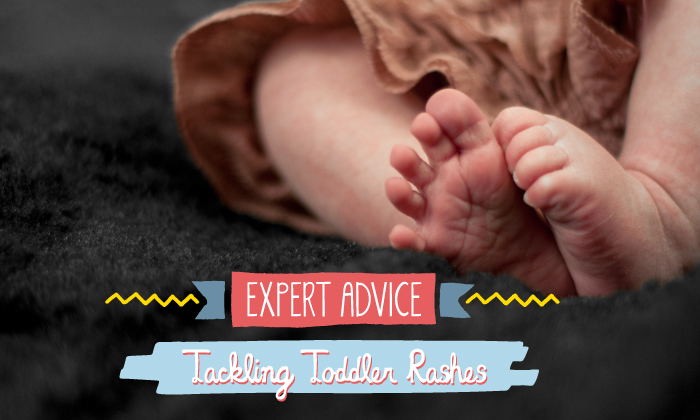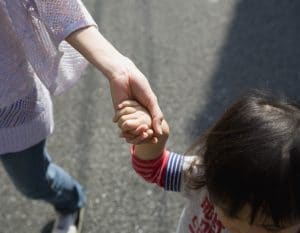
 Post Category - ParentingParenting - Post Category - BabyBaby
Post Category - ParentingParenting - Post Category - BabyBaby Post Category - WellnessWellness - Post Category - HealthHealth
Post Category - WellnessWellness - Post Category - HealthHealthRashes are an unpleasant reality of life with a baby or toddler, here’s a quick guide for mamas from a paediatrician to put your mind at ease, mama!
Please welcome paediatrician Dr. Leo Hamilton of International Medical Clinic with a handy primer for mamas on rashes commonly seen in babies and toddlers. It’s may not be a fun topic, mama, but it’s a vital one!
Is your child’s body covered in red spots after a virus, or are blisters appearing? Rashes in a baby or toddler can be pretty sudden and alarming. A rash is a reaction of the skin and can be caused by many things: an infection, an allergy, or the heat outside in the tropics. The good news is that most rashes are not dangerous and will fade in time on their own or with a little help from a doctor.

To find out the rash you might be dealing with, keep on reading below for the most common rashes seen in babies and toddlers, including symptoms and treatment options. The good news is that almost all of these are fairly common and relatively harmless!
If the rash is red from head to toe after a fever or cold virus
…It’s probably a “post-viral” rash. The rash is harmless, causes no symptoms (at most a bit of itching), and is typically seen as your child recovers from a virus. It usually starts on the head or chest and can spread in a day over the entire body. It usually goes away after 2-3 days and does not need treatment. Typically this type of rash disappears if you stretch the skin.
If the rash is dark spots from head to toe after a fever or cold virus
…It’s probably petechiae. This rash also usually has no symptoms and occurs after a common cold virus. It can rarely be dangerous, and if these spots appear (they are tiny bruises in the skin), you need to call your doctor, especially if any spots appear inside the mouth. The big difference between this rash and a post-viral rash is that the spots do not disappear if you stretch the skin.
If the rash is red spots or blisters on the hands, feet, and buttocks
…It’s probably hand-foot-and-mouth disease. It’s a very common virus in Singapore, usually starting with a mild fever. The next day the fever is gone and a red rash and possibly blisters appear on the hands, feet, and often the buttocks. The rash needs no treatment. The only worry is due to the sores in the mouth – if severe they can be painful. The good news is most toddlers have a mild course and don’t have too much pain (little babies are more vulnerable). The only treatment is a pain medicine like a paracetamol or ibuprofen.
If the rash is small, clear or red bumps, often around the neck or where clothes are tight
…It’s likely to be heat rash. It is caused by the warm tropical air leading to clogged skin pores. It rarely causes problems beyond a mild itching, and tends to come and go. Treatment is simple – wear loose-fitting clothing and the rash will get clear up on its own within a few days. Drying powders can help, but creams and ointments may make the rash worse by clogging more pores.
If the rash is very itchy blisters spreading rapidly a day after a fever
…It is likely to be chickenpox. It’s caused by a virus, and the spots can take as much as two weeks to heal. Some spots can permanently scar, especially if scratched. There are no effective medicines other than anti-itch lotions like Calamol. Though it usually causes no serious problems, it can be prevented or made very mild by the chickenpox vaccine.
If the rash is red, itchy patches of open skin, often draining a yellowish fluid
… It is likely to be impetigo. It’s a bacterial skin infection and can spread rapidly, usually after scratching an itchy sore. Early on, it can be treated with antibiotic ointment, but if it’s spreading it usually takes antibiotics by mouth.
If the rash is red, itchy, rough, and usually in patches
…It’s likely to be eczema. In toddlers it usually has no obvious cause, but food allergies and viral infections can cause it to flare. Moisturizers can resolve mild eczema, but if it is more severe, see your doctor for a proper diagnosis and medication to ease the symptoms.
If the rash is small, fleshy, wart-like spots, often under the arms or on the chest
…It’s likely to be molluscum contagiosum. Also called “water warts,” it’s caused by a harmless virus. It does not cause any problems if left alone, and it will go away without treatment (though it may take 6 or more months). If it spreads, or if it gets irritated (usually if it’s scratched at), it can be easily treated.

The above is a guide only and we recognise that rashes can be worrying. Please get in touch with your doctor if have any concerns at all.
International Medical Clinic (IMC)
Camden Clinic, 1 Orchard Boulevard, #14-06 Camden Medical Centre, Singapore 248649, Tel: (+65) 6733 4440
Paediatric Clinic, 1 Orchard Boulevard, #11-06 Camden Medical Centre, Singapore 248649, Tel: (+65) 6887 4440
Jelita Clinic, 293 Holland Road, #02-04 Jelita Shopping Centre, Singapore 278628, Tel: (+65) 6465 4440
East Coast Clinic, 88 East Coast Road, #02-07 Katong Square, Singapore 423371, Tel: (+65) 6342 4440






 View All
View All




 View All
View All











 View All
View All






